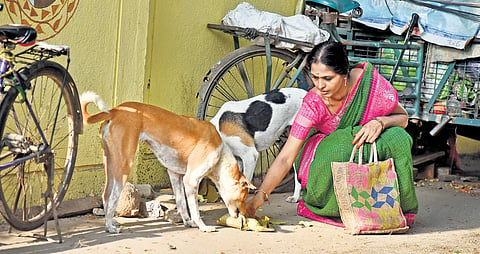

CHENNAI: Every morning at precisely 7:30 am, a pack of stray dogs gathers outside Narmadha Thiagarajan’s modest home in Virugambakkam. With her neighbour, 86-year-old Sundarajan by her side, Narmadha steps out of her home, bearing a tray of food for around 70 dogs. Immediately, a familiar sight ensues. Her canine companions circle her, tails wagging, a few sniffing her legs, and playful jumps.
The 43-year-old social science teacher is a godmother to the dogs of Virugambakkam. She feeds countless animals and gets most of them sterilised and vaccinated. “I am just a part-time member in a community dedicated to serving dogs. We have a Facebook group where we just share information on which dog needs help in a particular area,” she says.
Meanwhile, Sundarajan ensures that the dogs don’t fight and everyone gets their share during their morning feeding session. “I used to raise almost 20-25 dogs, but I wasn’t aware of sterilisation until Narmadha educated me on that. Soon, I handed them over to her for treatment.” From then on, Narmadha would tend to most furry denizens of the street.
When questioned about Narmadha’s inspiration behind the cause, she says, “I grew up in a farmhouse at Thammampatti village in Salem. We had many pet animals which never posed a threat to anybody. I witnessed firsthand the challenges they faced. Road accidents often left them injured and abandoned.”
Later in 2000, when she came to Chennai to pursue higher studies, she continued her efforts to rescue animals and joined the Blue Cross.
“I used to wonder who would provide food for all stray dogs. Initially, I spent my own money. Eventually, more dogs visited my home. There are times when my neighbours extend their helping hands and some volunteers provide food,” she adds.
She has also been sensitising her students for the past 10 years on how to protect animals. Many children approach her for medical care, which is provided with the help of veterinarians. “Fear is often instilled in the child’s mind by their parents and society. If we can guide the young minds, they are eager to help. If their parents are not willing though, I take it into my own hands,” she says.
She recounts a particularly painful incident that strengthened her mission. “Once when I was walking to school, I spotted a stray dog lying in the middle of the road in the scorching summer heat. It looked like a bag of bones and had its tongue bulging out due to thirst.” She recounted this to her students and along with them started filling up bowls of water and kept it in the school premises to provide drinking water for dogs.
Sheridan Rozario, an activist residing in the city, tells TNIE, “India is endemic for rabies and accounts for 39.9% of the world’s rabies deaths.” Drawing on his 25 years of experience as an animal activist, Rozario emphasised the importance of public participation in India, where an estimated six crore dogs live among a population of 140 crore. He encouraged people to adopt dogs and to come forward to get community dogs spayed and neutered.
On the human-animal conflict, Narmadha points out the issues have arisen since more buildings have popped up everywhere, eating up the dog’s and other animals’ ecosystem. One way to tackle this is to sterilise them and work with corporate officials to reduce their population.
She advised that if you find a dog, check if it has a notch hole (a permanent identification mark showing the stray has been sterilised) in its ear. If not, it needs to be captured and sterilised. However, the dog must be captured by someone it is familiar with — someone who feeds it regularly. Moreover, after sterilisation, they should be released into the same area they were captured from, or else they will panic and get into fights with other dogs and catch rabies.
However, most residents have raised complaints over her feeding the dogs. “Most of them have come around,” she says and recalls how a particular neighbour who used to frown at her for tending to dogs ended up approaching her regarding a weak dog. “We need to remove people’s fear and they will come around. An entire street that once tried to stop me is now with me, especially after noting my constant efforts,” she concludes.
(Edited by Mary Catherene)